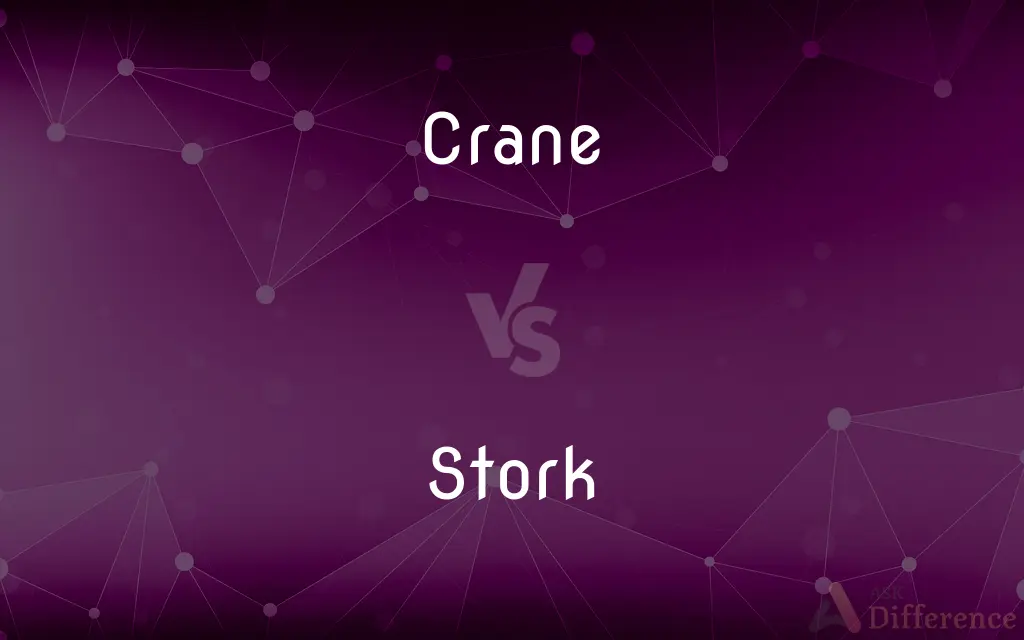Crane vs. Stork — What's the Difference?
Edited by Tayyaba Rehman — By Fiza Rafique — Updated on October 31, 2023
Crane is a tall, long-legged bird; also, a lifting machine. Stork is a tall, long-legged bird, often associated with childbirth.

Difference Between Crane and Stork
Table of Contents
ADVERTISEMENT
Key Differences
Cranes are large, long-legged and long-necked birds, known for their elaborate courtship dances. Storks are also tall and long-legged but are more associated with myths, such as delivering babies.
Many species of cranes migrate long distances, famous for their V-shaped flight formations. In contrast, not all stork species are migratory, and they are known to travel in flocks but without a specific formation.
In symbolism, cranes are often regarded as symbols of longevity and fidelity in many cultures. Storks symbolize good luck and are a popular motif in folklore, especially related to childbirth.
The diet of cranes can be quite varied, including small animals and grains. Storks, however, mostly feed on fish, insects, and small mammals, with some species known for living in proximity to human habitats.
Both cranes and storks are admired for their elegant appearance and graceful movements. However, the plumage of cranes can be more varied and colorful compared to the typically white and black colors of storks.
ADVERTISEMENT
Comparison Chart
Migration
Many species migrate long distances.
Not all species migrate; patterns vary.
Symbolism
Longevity, fidelity.
Childbirth, good luck.
Diet
Varied, includes small animals, grains.
Mostly fish, insects, small mammals.
Social Behavior
Often solitary or in pairs.
Often found in larger groups or colonies.
Appearance
Varied plumage, long legs, long neck.
Typically white and black, long legs.
Compare with Definitions
Crane
A tall, long-legged bird known for its elaborate dances.
The crane gracefully danced in the wetlands.
Stork
In myths, known for delivering babies.
The story of the stork bringing babies delighted the children.
Crane
Any of various large wading birds of the family Gruidae, having a long neck, long legs, and a long bill.
Stork
A tall, long-legged bird often associated with childbirth.
The stork nested on the chimney of the old house.
Crane
A similar bird, such as a heron.
Stork
Many species are subject to conservation efforts.
Conservationists are working to protect the habitat of the stork.
Crane
A machine for hoisting and moving heavy objects by means of cables attached to a movable boom.
Stork
Predominantly feeds on fish and small animals.
The stork waded through the water, hunting for fish.
Crane
Any of various devices with a swinging arm, as in a fireplace for suspending a pot.
Stork
Some species are migratory, traveling long distances.
In autumn, the storks began their migration south.
Crane
To hoist or move with or as if with a crane.
Stork
Storks are large, long-legged, long-necked wading birds with long, stout bills. They belong to the family called Ciconiidae, and make up the order Ciconiiformes .
Crane
To strain and stretch (the neck, for example) in order to see better.
Stork
Any of various large wading birds of the family Ciconiidae, having long legs and a long straight bill.
Crane
To stretch one's neck toward something for a better view.
Stork
A large wading bird with long legs and a long beak of the family Ciconiidae.
Crane
To be irresolute; hesitate.
Stork
(children's folklore) The mythical bringer of babies to families, or good news.
Crane
Any bird of the family Gruidae, large birds with long legs and a long neck which is extended during flight.
Stork
(cartomancy) The seventeenth Lenormand card.
Crane
Ardea herodias, the great blue heron.
Stork
Any one of several species of large wading birds of the family Ciconidæ, having long legs and a long, pointed bill. They are found both in the Old World and in America, and belong to Ciconia and several allied genera. The European white stork (Ciconia alba) is the best known. It commonly makes its nests on the top of a building, a chimney, a church spire, or a pillar. The black stork (C. nigra) is native of Asia, Africa, and Europe.
Crane
A mechanical lifting machine or device, often used for lifting heavy loads for industrial or construction purposes.
Stork
Large mostly Old World wading birds typically having white-and-black plumage
Crane
An iron arm with horizontal motion, attached to the side or back of a fireplace for supporting kettles etc. over the fire.
Crane
A siphon, or bent pipe, for drawing liquors out of a cask.
Crane
(nautical) A forked post or projecting bracket to support spars, etc.; generally used in pairs.
Crane
(obsolete) The cranium.
Crane
(ambitransitive) To extend (one's neck).
Crane
(transitive) To raise or lower with, or as if with, a crane.
Crane
(intransitive) To pull up before a jump.
Crane
A wading bird of the genus Grus, and allied genera, of various species, having a long, straight bill, and long legs and neck.
Crane
Any arm which swings about a vertical axis at one end, used for supporting a suspended weight.
Crane
A machine for raising and lowering heavy weights, and, while holding them suspended, transporting them through a limited lateral distance. In one form it consists of a projecting arm or jib of timber or iron, a rotating post or base, and the necessary tackle, windlass, etc.; - so called from a fancied similarity between its arm and the neck of a crane See Illust. of Derrick.
Crane
An iron arm with horizontal motion, attached to the side or back of a fireplace, for supporting kettles, etc., over a fire.
Crane
A siphon, or bent pipe, for drawing liquors out of a cask.
Crane
A forked post or projecting bracket to support spars, etc., - generally used in pairs. See Crotch, 2.
Crane
The American blue heron (Ardea herodias).
Crane
To cause to rise; to raise or lift, as by a crane; - with up.
What engines, what instruments are used in craning up a soul, sunk below the center, to the highest heavens.
An upstart craned up to the height he has.
Crane
To stretch, as a crane stretches its neck; as, to crane the neck disdainfully.
Crane
To reach forward with head and neck, in order to see better; as, a hunter cranes forward before taking a leap.
The passengers eagerly craning forward over the bulwarks.
Crane
United States writer (1871-1900)
Crane
United States poet (1899-1932)
Crane
Lifts and moves heavy objects; lifting tackle is suspended from a pivoted boom that rotates around a vertical axis
Crane
Large long-necked wading bird of marshes and plains in many parts of the world
Crane
Stretch (the neck) so as to see better;
The women craned their necks to see the President drive by
Crane
A device for lifting and moving heavy objects.
They used a crane to hoist the beams onto the building.
Crane
To stretch one's neck to see something better.
She had to crane her neck to see the parade over the crowd.
Crane
In many cultures, a symbol of longevity and fidelity.
The crane is revered in Asian art for its symbolic meanings.
Crane
Essential machinery in building and engineering.
The skyline was dotted with cranes at the construction site.
Common Curiosities
Can cranes be found worldwide?
Cranes are found on all continents except South America and Antarctica.
What is the crane known for in nature?
The crane is known for its long legs, long neck, and elaborate dances.
Are cranes solitary birds?
Cranes can be found alone or in pairs, though they gather in groups during migration.
Do all storks migrate?
Not all stork species migrate; some are resident, depending on the species.
What do storks eat?
Storks primarily eat fish, insects, and small mammals.
Are storks social birds?
Many stork species are quite social, living in colonies or large groups.
What does the stork symbolize in folklore?
In folklore, the stork symbolizes childbirth and good luck.
Are crane species endangered?
Some crane species are endangered due to habitat loss and other factors.
Do storks really deliver babies?
The idea of storks delivering babies is a myth and not based on reality.
What is the crane's typical habitat?
Cranes inhabit a variety of habitats including wetlands, grasslands, and marshes.
What role do cranes play in construction?
Cranes are vital in construction for lifting and moving heavy materials.
Is there a cultural significance to cranes?
Yes, cranes hold cultural significance in many societies, symbolizing longevity and fidelity.
Are cranes protected by law?
Many countries have laws and conservation efforts in place to protect crane species and their habitats.
How do storks interact with humans?
Some stork species adapt well to human environments and can be seen living near villages or towns.
Where do storks typically nest?
Storks often nest on high structures like chimneys, trees, or cliffs.
Share Your Discovery

Previous Comparison
Northbridge vs. Southbridge
Next Comparison
Scholarship vs. SponsorshipAuthor Spotlight
Written by
Fiza RafiqueFiza Rafique is a skilled content writer at AskDifference.com, where she meticulously refines and enhances written pieces. Drawing from her vast editorial expertise, Fiza ensures clarity, accuracy, and precision in every article. Passionate about language, she continually seeks to elevate the quality of content for readers worldwide.
Edited by
Tayyaba RehmanTayyaba Rehman is a distinguished writer, currently serving as a primary contributor to askdifference.com. As a researcher in semantics and etymology, Tayyaba's passion for the complexity of languages and their distinctions has found a perfect home on the platform. Tayyaba delves into the intricacies of language, distinguishing between commonly confused words and phrases, thereby providing clarity for readers worldwide.















































